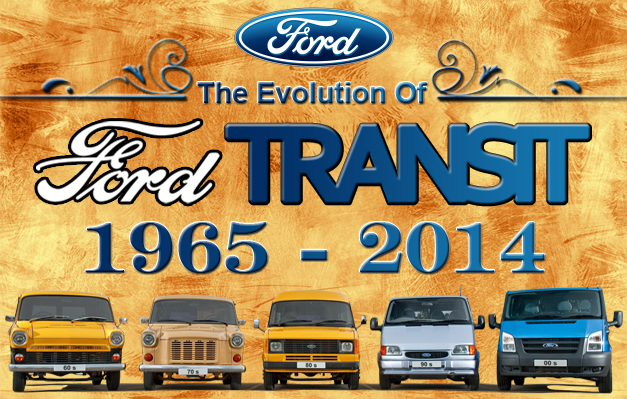

Transit is one of the most successful Ford nameplates in the world. The Ford Transit is a range of light commercial vehicles produced and sold not only in the UK but also in several other countries by Ford Motor Company since 1965. Over seven million Transits have been produced across four basic platform generations debuting in 1965, 1986, 2000, and 2013 respectively.
The Transit has been the best-selling light commercial vehicle in Europe for 40 years, and in some countries the term “Transit” has passed into common usage as a generic term applying to any light commercial van.
The first generation was not produced by Ford UK but was built in Ford’s Koln (Cologne) production facility in Germany. It was unveiled in 1953 as FK 1000 (Ford Köln with a carrying capacity of 1,000 kg with a 1.3 litre inline-four engine from Taunus. From 1955 to 1965 it was named as Ford Taunus Transit, however the production was permanently stopped in 1965.
This much-loved motor has been the four-wheeled foundation of British business, from its launch in October 1965
1966 – Perkins 4/99 diesel engine swapped by Perkins 4/108.
1967 – Transit is offered in two wheelbase editions, long as well as short.
1971 – Exterior changes with an eye-catching, car-like grille introduced,
1972 – New model arrangement to replicate the change to metric. Model number descriptions as payload divided by ten.
1972 – The Perkins engines were swapped by Ford’s own high rev “York” engines.
1975 – Transit interior is modified with 100mm of legroom and enhanced driving position with extended steering column.
1975 – The Ford 1.7-litre ‘Essex’ V4 engine is swapped by the more economical 1.6-litre ‘Kent’ engine.
1976 – for the first-time Transit gains disc brakes at the front.
1978 – Transit receives a noteworthy facelift with a more aerodynamic and extended bonnet to hold up more fuel-efficient OHC engines.
1978 – Ford’s C3 automatic transmission is introduced, as well as a more powerful heating system is equipped
1984 – Transit gains Ford’s Dagenham-built direct injection fuel system and rotary fuel injection pump. It gains fuel efficiency and increased power comparative to “York” engines.
1986 – An all-new Ford Transit is unveiled with aerodynamic cabin styling that allowing fuel savings of up to 8 percent compared to previous generation. Other features include, wide bonnet, larger doors to facilitate one metre pallet. Increased load space by 13 percent.
The Transit Mark II debuted with a restyled front section, lifted from the US Mark III with the prologue of the Pinto engine from the Cortina in place of the Essex V4
The third-generation Transit introduced in January 1986 and was notable for its all-new bodyshells with “one-box” design and fully independent front suspension on SWB version
The fourth-generation Transit, was the new millennium van, introduced in July 2000, borrowed styling cues from Ford Focus, and Ka
2000 – Ford Transit features the “Puma”-type Duratorq turbo diesel engine also used in the 2000 Mondeo moving up to the 2.3 litres 16-Valve edition of the l-4 engine
2001 – The Transit won the International Van of the Year Award 2001
2002 – First High Pressure Common Rail Ford Transit diesel engine introduced, with the launch of the 125 PS (92 kW) HPCR 2.0-litre in the FWD
2002 – Ford transit connect is introduced with small panel van based on the C170 Ford Focus platform
2003 – The Transit received technological advancements of new millennium with a new instrument cluster with a digital odometer
2004 – The launch of the first RWD HPCR, 2.4-litre variant with 135ps further enhanced with the 6-speed MT-82 RWD manual gearbox
2005 – The five millionth Transit rolled off the Southampton assembly facility on Monday, 18 July 2005 and was donated to an English charity
Fifth-generation Ford celebrating 50 years of Transit and introduced the Sport Van
2006 – Entirely renovated interior with gearstick on dash, facelift and sporty cues
2007 – The engine line-up and powertrains were changed to meet new emissions legislation.
2007 – Won the Van Of The Year 2007 award and received a five cylinder engine
2007 – Transit XXL a stretched model was introduced as ever expensive transit
2008 – Coated Diesel Particulate Filter and 6-speed transaxle was introduced on the mid-power FWD
2008 – the current Euro IV edition was introduced to meet emission requirements, as an option on all diesel engines.
A globally designed vehicle, the new-generation Transit is collaboration between Ford of Europe and Ford in North America.
2013 – Ford Transit Tourneo Custom unveiled at Geneva Motor Show 2013
2013 – Transit shares the 3.7L Ti-VCT and 3.5L EcoBoost V6 engines with the F-150
2013 – The 3.2L Duratorq inline-5 diesel introduced in North America as a Power Stroke diesel
2013 – A 6-speed automatic transmission and rear-wheel drivetrain is introduced
2013 – The 3.7L Ti-VCT V6 can be converted to run on CNG or LPG with an optional Gaseous Engine
The new Transit looks like no Transit before, with a bold new design which has a distinctively modern and sporty feel,” said Paul Campbell, Commercial Vehicle Chief Designer, Ford of Europe
